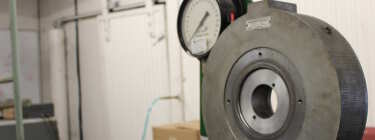Do torque charts for tensioning fasteners apply to anchor bolts?
The AISC Steel Construction Manual, 13th Edition has this to say about anchor rod nut installation.
“The majority of anchorage applications in buildings do not require special anchor rod nut installation procedures or pretension in the anchor rod. The anchor rod nuts should be “drawn down tight” as columns and bases are erected. This condition can be achieved by following the same practices as recommended for snug-tightened installation in steel-to-steel bolted joints in the RCSC Specification. That is, most anchor rod nuts can be installed using the full effort of an ironworker with an ordinary spud wrench.
When, in the judgment of the owner’s designated representative for design, the performance of the structure will be compromised by excessive elongation of the anchor rods under tensile loads, pretension may be required. Some examples of applications that may require pretension include structures that cantilever from concrete foundations, moment-resisting column bases with significant tensile forces in the anchor rods, or where load reversal might result in the progressive loosening of the nuts on the anchor rods.
When pretensioning of anchor rods is specified, care must be taken in the design of the column base and the embedment of the anchor rod. The shaft of the anchor rod must be free of bond to the encasing concrete so that the rod is free to elongate as it is pretensioned. Also, loss of pretension due to creep in the concrete must be taken into account. Although the design of pretensioned anchorage devices is beyond the scope of this manual, it should be noted that pretension should not be specified for anchorage devices that have not been properly designed and configured to be pretensioned.”
So, in a nutshell, what does this mean?
It means, that in normal circumstances, the normal effort of an ironworker with a regular spud wrench is sufficient to tighten the nuts on anchor bolts. In the event that special pretensioning is required, the design engineer should have carefully designed the anchor assembly specifically for that purpose and there should be detailed instructions so that the pretensioning is carried out properly.





It’s amazing how many times you are asked the same question and you give the same answer, which is what your article lead with… i.e. “most anchor rod nuts can be installed using the full effort of an ironworker with an ordinary spud wrench.” or “snug tight”. The first question regarding the necessary torque to shear off a 3/4 galvanized anchor, which I assume meant “how much is too much?” was about the best, but as you know, the number could be higher and it could be lower as you noted. I just read, then reread all of these questions and then your reasonable responses and just couldn’t refrain from throwing in my two cents. You guys are the best at what you do and please keep providing logical info like this for all of us. K
How much torque does it take to shear off a 3/4 galvanized anchor
@Thomas- It will depend on a number of factors; like coating, amount (if any) of rust, and the amount of lubrication (oil, wax, etc). Assuming this is a low carbon grade like F1554g36, the torque needed to bring the bolt to failure should be anywhere between 200-400 ft-lbs. If the nut gets cross threaded or galls, or if there is previous damage, the number could also be significantly lower.
Good morning, i have 3/4″ ASTM F1554 Grade 36 Anchor Bolts that are embedded in concrete for a Pump House at my job site and i would like to know if there is a required torque value for the said bolts ?
@Marthius- Per the AISC, anchor bolts are typically only torqued to snug tight. If the engineer requires anything other than that, they need to specify that.
In my reading of AISC, I observed that anchor bolts like A36/A307 are not mentioned clearly. I presumed to add more clear paragraphs and also tightening and even tables for anchor bolts and case to case basis.
Thanks Dane!
Perfect answers to every question!
Happy Friday
Syd
What is the number of ft lbs on a rachet to tighten nut on a 1/2” anchor bolt into floor concrete?
@Mario- For pre-installed anchor bolts (cast in place) the AISC only recommends that they be tightened snug tight. If you are using a proprietary post installed anchor, you would need to refer to that manufacturer’s recommendations.
What is the torque value for 1/2” Hilti mechanical wedge anchor
@PJ- Apologies, but we do not typically resell Hilti items and are unfamiliar with their installation recommendations.
good afternoon,
The thread length indicated in the ASME B18.2.6 standard (bolts A325 and A490) is a minimum length?
@Diego- it is neither a minimum nor a maximum. The thread length is controlled by the grip gaging length, and the body length. As the body length varies, and the grip varies, the thread length will vary. The ASME B18.2.6 standard defines tolerances for both the body length and the grip length, but not for the thread length.
is it necessary to torque the liners which is hanged to the concrete. one long bolt is used.
first a vertical steel plate then concrete and after concrete again a steel plate. these 3 are connected with a single bolt. need t torque or snug tight. drawing it briefs only to clampin
@elvisjoy- We do not have any engineers on staff, so cannot make recommendations for specific applications. You will need to consult the project engineer.
Good Day, when will I know if i will apply torque to post-installed anchor bolts or not, and when will I only use “snug tight” on anchor bolts. Thanks in advance!
@Kenneth- The only time you should need to torque your anchor bolts is when the project engineer specifies it. Otherwise, snug tight should be sufficient.
Hello,
We are using three bolts supplied by your company 2″x34″, 1-1/2×27″, and 1-1/4×27″ all Galvanized F1554G55. These are anchor bolts for steel columns being erected in CA, there are eight per base. I am looking for a torque reference and I am having trouble finding it on your site when I came across this page referring to “Drawn down tight”.
Can you supply me with more info and or torque values? Thank you.
@Kevin- The AISC guidelines say that snug tight is all that is required for anchor bolts, unless the project engineer says otherwise. If that is the case, then he/she should supply you with the necessary information to torque them properly.
What happens if the bolts are not torqued properly?
We keep breaking them…
Is that the result of over or under torqueing?
@Luis- Every application will require a different amount of tension (torque). You may need to consult with the project engineer to determine the proper amount.
What is the structural torque for a a325 lajune bolt? If you can’t get the lajune gun on the bolt? The bolts are 3/4″. Thanks
@Tracy- There are no “official” torque values for TC bolts. The only way to determine the proper amount is to test the bolt in a tension measuring device. If you are having trouble with the bolts or the gun, you might need to replace one or both of them.
I am using heavy tied down brackets my trailer I am using 5/16 by 2 and half inch boats with lock nuts can you please tell me what foot pound torque would be proper to tighten them down
@Rich- I am sorry, but we can’t make torque recommendations for specific applications like that. Apologies.
I have a problem with the proper torque to be applied on anchor bolts used to secure rail fasteners down to concrete slabs for direct fixation transit track. The bolts are 7/8″ diameter and grouted into the concrete to a depth of 5 inches. The plates are laid over the anchor bolts and nutted down. What torque should be applied to the nuts?
@Don- As written in this FAQ, torque for anchor bolts is normally just snug tight. If your job requires a specific torque your project engineer or the plans should specify what that is.
Hi,
I wouls like to know what is the weight carrying capacity of M16, M20 and M24 bolts but specially nuts. i cam across an argument that there is no need to put steel packing or shims under the structural steel or pipe supports because the support is supported by the jacking nuts therefore i want to make sure that the nut used as jacking nut and carrying the weight of the steel is not too heavy for the nuts to fail.
keep me updated.
kind regards,
Ali
@Ali- I am sorry, we do not have any strength information for metric fasteners.
I have 3″ & 4″ Flange, Class 300 Flange.
1- Can I use 5/8″ bolts?
2- What would be the torque value for 3/4″ and 5/8″ bolts.
3- Basically this is for Novec fire fighting system the line will be pressurize only for 6-10 seconds only in the case of fire with pressure of 25 Bar. So what bolt torqueing value to be applied?
Please answer All Questions separately.
@Ali – Thank you for your question, but application specific questions are out of our area of expertise, you will need to consult an engineer to answer these.
Hi,
I would like to ask preferred Torque setting for 15 Meter mono pole foundation bolts Bolt Size is M36 and used Material is Q345B
Bolts are 1200 mm long and embedded in Concrete.
If needed I can share drawing.
Thanks in advance
Pyara Kamboj
@Pyara Kamboj – Apologies, but Portland Bolt cannot make specific application recommendations like this. Additionally, we do not work with metric fasteners and are not familiar with Q345B material so are unable to help with this request.
We have a solar thermal power project at Pokran Rajasthan India where foundfation bolts embedded in concrete is required to be pretensioned. Can you please suggest suitable method for acheiving this. We can send you the foundation drawing if you wish to see the complete details.
@S.K. Sampath – Apologies, but we do not have any application engineers on staff, you will need to contact one to get recommendations for pretensioning.